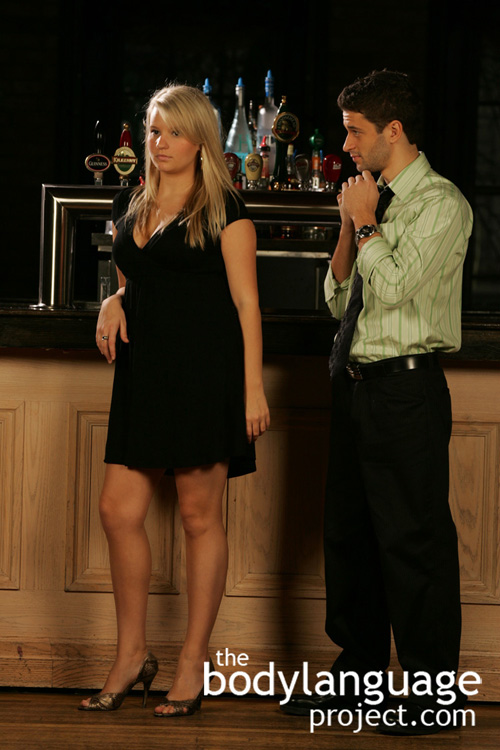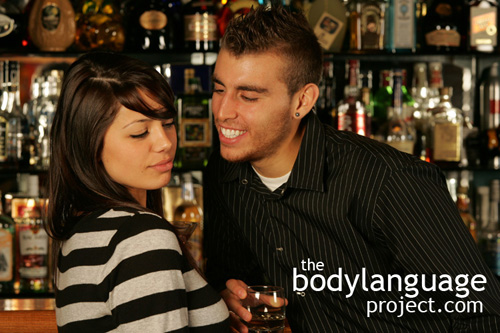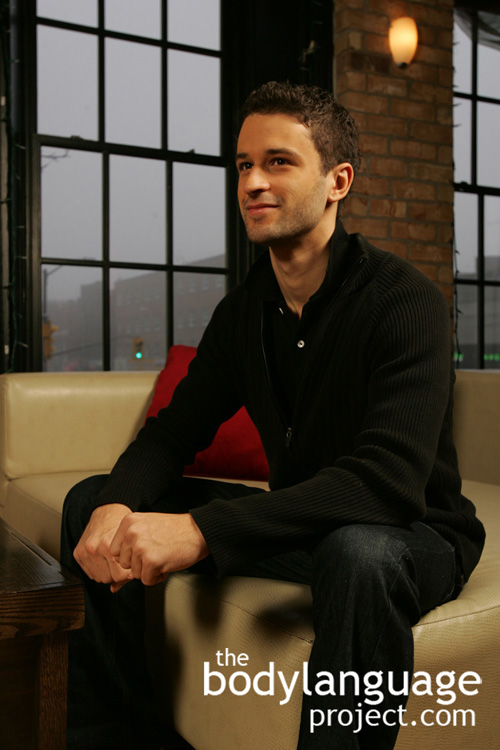Body Language of Hand Wringing
 Cue: Hand Wringing
Cue: Hand Wringing
Synonym(s): Wringing The Hands.
Description: The hands are clasp one inside the other and tightly clamped and twisted on each other. The hands may also be tightly cupped and squeezed one inside the other or interlaced and squeezed. It can be done so aggressively that the fingers or knuckles turn white.
In One Sentence: Wringing the hands is a sign that a person is experiencing anxiety, stress or suffering from low confidence.
How To Use it: Wringing the hands is not useful and one should avoid it when possible. While it can provide a tactile release for underlying stress, it is best to do something proactive to actually resolve the issue rather than suppress it.
Context: General.
Verbal Translation: “I’m so agitated and stressed that I’m inflicting pain on myself as I would like to do to someone else, or due to stress of the situation at large. Since I’ve lost control of the situation and others, the best I can do is control the pain I do onto myself.”
Variant: This cue is similar to self pinching, pulling or even plucking the hair, or pinching one’s self as they are all forms of inflicting pain on the self. This is especially common when external pain can not be controlled.
Cue In Action: She wrung her hands as she waited for the doctor to report back with news about the surgery.
Meaning and/or Motivation: It signifies high anxiety, stress, or low confidence, and is a pacifying behaviour.
The hands are clenched because of the internal turmoil that a person feels that they cannot resolve through external factors. Pain that is inflicted on the self is pain that is controlled by the self. Therefore, self-pain is pain that is used to regain some agency over a person’s outcome – even if it is entirely unproductive.
Clenching is also a replacement for pain that someone might wish to inflict on other people whom they feel are causing their problems, and if not caused by people directly, than to the context in general.
Cue Cluster: Hand wringing is usually accompanied by gritting the teeth or jaw clenching, scratching and plucking behaviours, licking the teeth to sooth, lip biting or cheek chewing, eye squinting, snarling, amongst others.
Body Language Category: Aggressive body language, Anger, Clenching and gripping, Closed body language, Dislike (nonverbal), Emotional body language, Energy Displacement, Frustration or frustrated body language, Hostile body language, Low confidence hand displays, Nervous body language, Stressful body language, Worry body language.
Resources:
Burd, L. ; Gascon, G. ; Kerbeshian, J. Rett Syndrome: Case reports and management strategies. Neuroscience and Biobehavioral Reviews. 1988. 12(3): 283-287.
Breau, Lynn M. ; Camfield, Carol S. ; Symons, Frank J. ; Bodfish, James W. ; MacKay, Alison ; Finley, G.Allen ; McGrath, Patrick J. Relation between pain and self-injurious behavior in nonverbal children with severe cognitive impairments. The Journal of Pediatrics. 2003 142(5): 498-503.
Borenstein, Lynn. The development of friendship in childhood: A clinical conversation. Child and Adolescent Social Work Journal. 1996. 13(3): 213-224.
Bodie, Grahamd. ; Villaume, Williama. Men and Women Holding Hands Revisited: Effects of Mutual Engagement and Hand Dominance on Attributions of Cross-Sex Handholding. Communication Research Reports. 2008. 25(4): 243-254.
Barroso, Felix ; Feld, Jason. Self-touching and attentional processes: The role of task difficulty, selection stage, and sex differences. Journal of Nonverbal Behavior. 1986. 10(1): 51-64.
Butzen, Nathan David ; Bissonnette, Victor ; Mcbrayer, Dan. Effects of modeling and topic stimulus on self-referent touching. Perceptual and motor skills. 2005. 101(2): 413-20.
Broome, Marion E.. Helping Parents Support Their Child In Pain. Pediatric Nursing. 2000. 26(3): 315.
Bornstein, Marc H. ; Tamis-Lemonda, Catherine S. Maternal responsiveness and infant mental abilities: Specific predictive relations. Infant Behavior and Development. 1997. 20(3): 283-296.
Buckley, V., & Semple, S. (2012). Evidence that displacement activities facilitate behavioural transitions in ring-tailed lemurs. Behavioural Processes, 90, 433–435.
Bernal, Gilda Rios ; Wortham, Suec. How to Calm Children through Massage. Childhood Education. 1997. 74(1): 9-14.
Bouhuys, A.L. ; Jansen, C.J. ; van den Hoofdakker, R.H. Analysis of observed behaviors displayed by depressed patients during a clinical interview: relationships between behavioral factors and clinical concepts of activation. Journal of Affective Disorders. 1991. 21(2): 79-88.
Bouhuys, A.L. ; Beersma, Domien G.M. ; van den Hoofdakker, Rutger H. Observed behavior as a predictor of the response to sleep deprivation in depressed patients. Psychiatry Research. 1989. 28(1): 47-61.
Berridge CW,Mitton E, ClarkW, Roth RH. 1999. Engagement in a non-escape (displacement) behavior elicits a selective and lateralized suppression of frontal cortical dopaminergic utilization in stress. Synapse 32:187–197.
Caplovitz Barrett, Karen. The origins of social emotions and self-regulation in toddlerhood: New evidence. Cognition & Emotion. 2005. 19(7): 953-979.
Castles, Duncan L. ; Whiten, Andrew ; Aureli, Filippo. Social anxiety, relationships and self-directed behaviour among wild female olive baboons. Animal Behaviour. 1999. 58(6): 1207-1215.
Croyle, Kristin L. ; Waltz, Jennifer. Subclinical Self-Harm: Range of Behaviors, Extent, and Associated Characteristics. American Journal of Orthopsychiatry. 2007. 77(2): 332-342.
D’alessio, M. ; Zazzetta, A. Development of Self-Touching Behavior in Childhood. Perceptual and Motor Skills. 1986. 63(1): 243-253.
DeSteno, D.; Breazeal, C.; Frank, R. H.; Pizarro, D.; Baumann, J.; Dickens, L, and Lee, J. Detecting the Trustworthiness of Novel Partners in Economic Exchange. Psychological Science. 2012. 23, 1549-1556.
http://bodylanguageproject.com/articles/use-body-language-cues-create-trust
Flores, Luis E. ; Berenbaum, Howard. Desire for emotional closeness moderates the effectiveness of the social regulation of emotion. Personality and Individual Differences
Gulledge, Andrewk. ; Gulledge, Michelleh. ; Stahmannn, Robertf.. Romantic Physical Affection Types and Relationship Satisfaction. The American Journal of Family Therapy. 2003. 31(4): 233-242.
Gulledge, Andrew K ; Stahmann, Robert F ; Wilson, Colwick M. Seven types of nonsexual romantic physical affection among Brigham young university students. Psychological reports. 2004. 95(2): 609-14.
Goldberg, Shelly ; Rosenthal, Robert. Self-touching behavior in the job interview: Antecedents and consequences. Journal of Nonverbal Behavior. 1986. 10(1): 65-80.
Harriss, Louise ; Hawton, Keith. Deliberate self-harm in rural and urban regions: A comparative study of prevalence and patient characteristics. Social Science & Medicine. 2011. 73(2): 274-281.
Hung, Iris W. and Aparna A. Labroo. From Firm Muscles to Firm Willpower: Understanding the Role of Embodied Cognition in Self-Regulation. Journal of Consumer Research. 2011 37(6): 1046-1064. http://www.jstor.org/stable/10.1086/657240
http://bodylanguageproject.com/articles/firm-muscles-lead-willpower/
Hernandez-Reif, Maria ; Diego, Miguel ; Field, Tiffany. Preterm infants show reduced stress behaviors and activity after 5 days of massage therapy. Infant Behavior and Development. 2007. 30(4): 557-561.
Harrison, Lynda Law. The use of comforting touch and massage to reduce stress for preterm infants in the neonatal intensive care unit. Newborn and Infant Nursing Reviews. 2001. 1(4): 235-241.
Hennessy, Michael B ; T. Williams, Michael ; Miller, Deborah D ; Douglas, Chet W ; Voith, Victoria L. Influence of male and female petters on plasma cortisol and behaviour: can human interaction reduce the stress of dogs in a public animal shelter?
Applied Animal Behaviour Science. 1998. 61(1): 63-77.
Harrigan, Jinni A. Self-touching as an indicator of underlying affect and language processes. Social Science & Medicine. 1985. 20(11): 1161-1168.
Harrigan, Jinni A.; Karen S. Lucic; Denise Kay; Anne McLaney and Robert Rosenthal. Effect of Expresser Role and Type of Self-Touching on Observers’ Perceptions. Journal of Applied Social Psychology. 1991. 21(7): 585-609.
Heaven, Laura ; Mcbrayer, Dan ; Prince, Bob. Role of sex in externally motivated self-touching gestures. Perceptual and motor skills. 2002. 95(1): 289-94.
Heaven, L ; Mcbrayer, D. External motivators of self-touching behavior. Perceptual and motor skills. 2000. 90(1): 338-42.
Jaquier, Véronique ; Hellmuth, Julianne C. ; Sullivan, Tami P.. Posttraumatic stress and depression symptoms as correlates of deliberate self-harm among community women experiencing intimate partnerviolence. Psychiatry Research. 2013. 206(1): 37-42.
Jacobson, Colleenm. ; Muehlenkamp, Jenniferj. ; Miller, Alecl. ; Turner, J. Blake. Psychiatric Impairment Among Adolescents Engaging in Different Types of Deliberate Self-Harm. Journal of Clinical Child & Adolescent Psychology. 2008. 37(2): 363-375.
Kirschbaum C, Pirke K-M, Hellhammer DH. 1993. The ‘Trier Social Stress Test’: a tool for investigating psychobiological stress responses in a laboratory setting. Neuropsychobiology 28: 76–81.
Katza, Carmit; Irit Hershkowitz; Lindsay C. Malloya; Michael E. Lamba; Armita Atabakia and Sabine Spindlera. Non-Verbal Behavior of Children Who Disclose or do not Disclose Child Abuse in Investigative Interviews. Child Abuse & Neglect. 2012. 36: 12-20.
http://bodylanguageproject.com/articles/reading-nonverbal-behaviour-child-abuse-cases-encourage-children-divulge-information-truth-telling
Laye – Gindhu, Aviva ; Schonert – Reichl, Kimberly A.. Nonsuicidal Self-Harm among Community Adolescents: Understanding the “Whats” and “Whys” of Self-Harm. Journal of Youth and Adolescence. 2005. 34(5): 447-457.
Maestripieri D, Schino G, Aureli F, Troisi A. 1992. A modest proposal: displacement activities as an indicator of emotions in primates. Anim Behav 44:967–979.
Mohiyeddini, C., Bauer, S., & Semple, S. (2013a). Displacement behaviour is associated with reduced stress levels among men but not women. PLoS One, 8, e56355.
Mohiyeddini, C., Bauer, S., & Semple, S. (2013b). Public self-consciousness moderates the link between displacement behaviour and experience of stress in women. Stress, 16, 384–392.
Mohiyeddini, C., & Semple, S. (2013). Displacement behaviour regulates the experience of stress in men. Stress, 16, 163–171.
Marcus-Newhall A, Pedersen WC, Carlson M, Miller N. 2000. Displaced aggression is alive and well: a meta-analytic review. J Pers Soc Psychol 78:670–689. Ingram GIC. 1960. Displacement activity in human behavior. Am Anthropol. 62:994–1003.
Navarro, Joe. 2008. What Every BODY is Saying: An Ex-FBI Agent’s Guide to Speed-Reading People. William Morrow Paperbacks.
Nock, Matthew K. Actions speak louder than words: An elaborated theoretical model of the social functions of self-injury and other harmful behaviors. Applied and Preventive Psychology. 2008. 12(4): 159-168.
O’sullivan, Lucia F. ; Cheng, Mariah Mantsun ; Harris, Kathleen Mullan ; Brooks-gunn, Jeanne. I Wanna Hold Your Hand: The Progression of Social, Romantic and Sexual Events in Adolescent Relationships. Perspectives on Sexual and Reproductive Health. 2007. 39(2): 100-107.
Pecora, Giulia ; Addessi, Elsa ; Schino, Gabriele ; Bellagamba, Francesca. Do displacement activities help preschool children to inhibit a forbidden action? Journal of Experimental Child Psychology. 2014. 126: 80-90.
Pettijohn, Terry F. , Ii ; Ahmed, Shujaat F. ; Dunlap, Audrey V. ; Dickey, Lauren N. Who’s got the upper hand? Hand holding behaviors among romantic couples and families.(Report). Current Psychology. 2013. 32(3): 217(4).
Ross, Shana ; Heath, Nancy. A Study of the Frequency of Self-Mutilation in a Community Sample of Adolescents. Journal of Youth and Adolescence. 2002. 31(1):.67-77.
Rosenbloom, Tova ; Ben-Eliyahu, Adar ; Nemrodov, Dan. Children’s crossing behavior with an accompanying adult. Safety Science. 2008. 46(8): 1248-1254.
Rubin, Mark Morrison, Todd G. (editor). Social Affiliation Cues Prime Help-Seeking Intentions. Canadian Journal of Behavioural Science/Revue canadienne des sciences du comportement. 2011. 43(2): 138-141.
Seekles, Wike ; van Straten, Annemieke ; Beekman, Aartjan ; van Marwijk, Harm ; Cuijpers, Pim. Effectiveness of guided self-help for depression and anxiety disorders in primary care: A pragmatic randomized controlled trial. Psychiatry Research. 2011. 187(1): 113-120.
Straker, Gillian. Signing with a Scar: Understanding Self-Harm. Psychoanalytic Dialogues. 2006. 16(1): 93-112
Schubert, Thomas W. and Sander L. Koole. The Embodied Self: Making A Fist Enhances Men’s Power-Related Self-Conceptions. Journal of Experimental Social Psychology. 2009; 45: 828–834.
http://bodylanguageproject.com/articles/the-power-of-a-balled-fist-making-a-fist-makes-men-feel-more-powerful/
Schaafsma, Juliette ; Krahmer, Emiel ; Postma, Marie ; Swerts, Marc ; Balsters, Martijn ; Vingerhoets, Ad. Comfortably Numb? Nonverbal Reactions to Social Exclusion. Journal of Nonverbal Behavior. 2015. 39(1): 25-39.
Schino G, Perretta G, Taglioni AM, Monaco V, Troisi A. 1996. Primate displacement activities as an ethopharmacological model of anxiety. Anxiety 2:186–191.
Supplee, Lauren H ; Skuban, Emily Moye ; Shaw, Daniel S ; Prout, Joanna. Emotion regulation strategies and later externalizing behavior among European American and African American children. Development and Psychopathology. 2009. 21(2): 393-415.
Troisi A. 1999. Ethological research in clinical psychiatry: the study of nonverbal behaviour during interviews. Neurosci Biobehav Rev 23:905–913.
Troisi A. 2002. Displacement activities as a behavioral measure of stress in nonhuman primates and human subjects. Stress 5: 47–54.
Toronto, Ellen L.K. A clinician’s response to physical touch in the psychoanalytic setting. International Journal of Psychotherapy. 2002 7(1): 69-81.
Tureck, Kim ; Matson, Johnny L. ; Beighley, Jennifer S. An investigation of self-injurious behaviors in adults with severe intellectual disabilities. Research in Developmental Disabilities. 2013. 34(9): 2469-2474.
Vannorsdall, Tracy ; Dahlquist, Lynnda ; Shroff Pendley, Jennifer ; Power, Thomas. The Relation Between Nonessential Touch and Children’s Distress During Lumbar Punctures. Children’s Health Care. 2004. 33(4): 299-315.
Williams, Trish ; Connolly, Jennifer ; Cribbie, Robert. Light and Heavy Heterosexual Activities of Young Canadian Adolescents: Normative Patterns and Differential Predictors.(Author abstract)(Report). Journal of Research on Adolescence. 2008. 18(1): 145(28).









